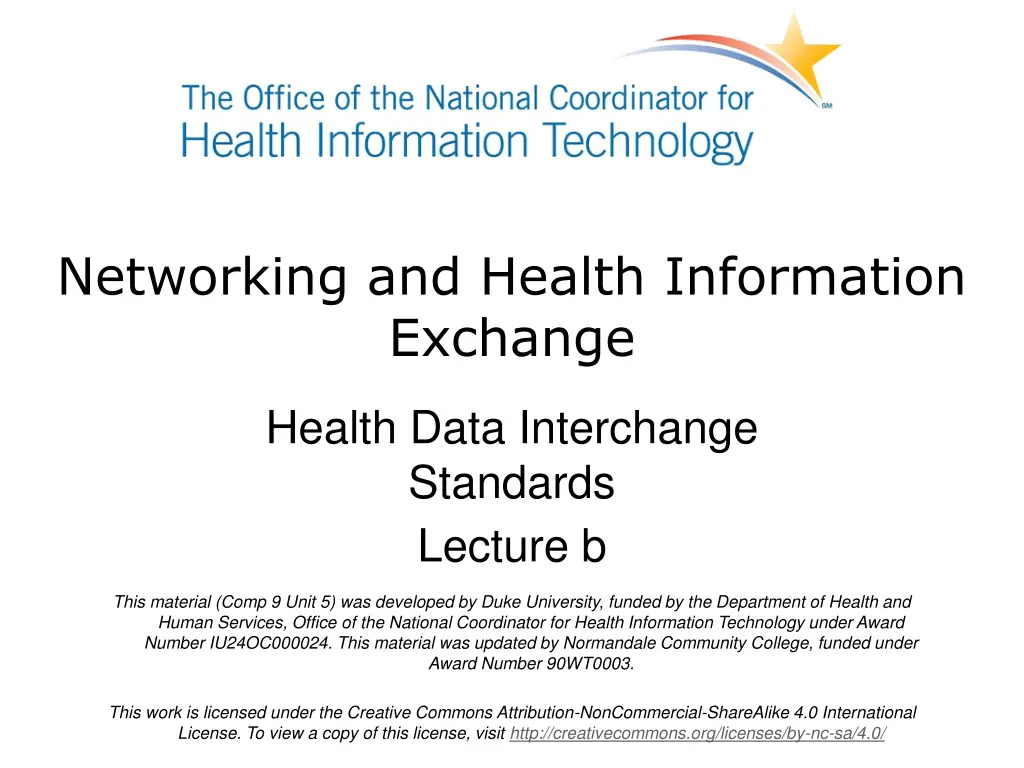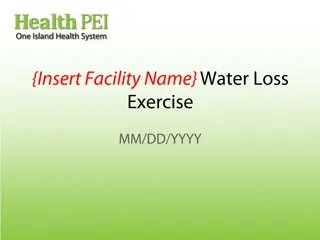
Understanding HL7 v3 Messaging Standards and Reference Information Model
Explore the development and importance of HL7 v3 messaging standards, including the Reference Information Model (RIM). Learn how v3 standards go beyond messaging to address various functionalities and domains, all based on an explicit information model known as the RIM. Discover the abstract nature of the RIM and its role in enabling communication and interoperability across different domains within the healthcare industry.
Uploaded on | 1 Views
Download Presentation

Please find below an Image/Link to download the presentation.
The content on the website is provided AS IS for your information and personal use only. It may not be sold, licensed, or shared on other websites without obtaining consent from the author. If you encounter any issues during the download, it is possible that the publisher has removed the file from their server.
You are allowed to download the files provided on this website for personal or commercial use, subject to the condition that they are used lawfully. All files are the property of their respective owners.
The content on the website is provided AS IS for your information and personal use only. It may not be sold, licensed, or shared on other websites without obtaining consent from the author.
E N D
Presentation Transcript
Networking and Health Information Exchange Health Data Interchange Standards Lecture b This material (Comp 9 Unit 5) was developed by Duke University, funded by the Department of Health and Human Services, Office of the National Coordinator for Health Information Technology under Award Number IU24OC000024. This material was updated by Normandale Community College, funded under Award Number 90WT0003. This work is licensed under the Creative Commons Attribution-NonCommercial-ShareAlike 4.0 International License. To view a copy of this license, visit http://creativecommons.org/licenses/by-nc-sa/4.0/
Health Data Interchange Standards Learning Objectives Understand HL7 v3.0 messaging standards Learn about the HL7 v3 Reference Information Model (RIM) Understand what is different about HL7 v3 compared to v2.n Understand the HL7 v3 domains 2
v3 Standards Are based on an explicit information model Use a defined process, called a methodology development framework (MDF), to create a family of standards v3 includes a family of standards beyond messaging that address a wider domain of functionality 3
v3 Messaging Standard Based on an object information model, called the Reference Information Model, (RIM) This model is abstract, that is, it is defined without regard to how it is represented in a message on the wire or in a service architecture method or in a clinical document In fact, each of these representations can contain the same instance of information Consequently, can be extended incrementally when new clinical information domains need to be added, in a way that doesn t require changing what has already been created 4
Why Cross-Reference to the RIM? Domain analysis models support communication within a domain Communications between domains requires an abstract, domain-independent model such as the HL7 RIM Cross-reference tables build the mappings from the narrow world of the individual domain to the cross-domain interoperability supported by the HL7 RIM 5
HL7 v3 Reference Information Model: Core Classes Source: W Ed Hammond, PhD. Adapted from HL7 International RIM standard. 6
HL7 Development Framework Formal methodology for mapping any local , domain -specific system, such as a laboratory system in the v3 Reference model. Basic concept is that any system can be mapped into a neutral and formal UML-based Domain Analysis Model (DAM) with the help of domain experts. The DAM can then be mapped into the equivalent v3-RIM model. Mapping is bi-directional and highlights any changes needed by either the local system or the RIM to create a semantically complete mapping. RIM Harmonization process supports a standard way to add new domain requirements to the RIM in a way that doesn t invalidate the previously created models a feature of object-oriented paradigms. 7
HL7 Reference Categories Primary standards Fundamental Standards Clinical and Administrative Domains EHR profiles Implementation Guides Rules and References Education and Awareness 8
Model-Based Development Source: W Ed Hammond, PhD. 9
Whats Different About v3? Conceptual foundation A single, common reference information model to be used across HL7 Semantic foundation Explicitly defined concept domains drawn from the best terminologies Abstract design methodology That is technology-neutral Able to be used with whatever is the technology de jour o XML, UML, etc. Maintain a repository Database of the semantic content Ensures a single source and enable development of support tooling Source: HL7.org 10
HL7 Model Repository Database holding the core of HL7 semantic specifications RIM Storyboards Vocabulary domains Interaction models Message designs Message constraints Source: HL7.org 11
Tool Sets Permit management of repository content Review and browsing of semantic specifications Design of abstract information structures based on the RIM for use in messages, templates, documents, etc. Publish HL7 specifications and standards Support implementation of HL7 standards Source: HL7.org 12
Drivers for v3 Adoption Needed to support a large scale integration V3 has built-in support for Complex Data types supporting o Universally unique instance identifiers for persons, places, organizations, practitioners, URL s, orders, observations, etc. o Name data type Persons and organizations o Time and date-related data type forms o Codes Binding standard vocabularies to RIM attributes V3 s methodology of deriving its models from the RIM also supports semantic interoperability 13
Drivers for v3 Adoption - 2 Structural ontology A coherent set of models (structures), guaranteeing semantic interoperability and re-use, based on the RIM and data types, with integrated vocabulary support Identifier strategy supporting wide integration Model and Tools based design and implementation for implementations requiring large scale integration (city, region, province, nationwide, international) v3 has built-in support Source: HL7.org 14
HL7 Version 3.0 Use-case Model Reference Information Model Domain Information Model Message Information Model Message Object Diagram Hierarchical Message Description Common Message Element Type 15
Common Domains Common Message Element Types (CMETs) Template structures for complex administrative objects, such as o Address o Telephone number Shared Messages Clinical Statement 16
Administrative Management Accounting and billing Claims and reimbursement Patient Administration Personnel Management Scheduling 17
Infrastructure / Messaging Transmission Message Control Query Master File / Registry 18
Health and Clinical Management *Blood, Tissue and Organ *Care Provision Cardiology DAM Clinical Decision Support Clinical Document Architecture *Clinical Genomics *Immunization Laboratory Materials Management *Medical Records *Medication Observations Orders *Pharmacy Public Health Reporting Regulated Products Regulated Studies Specimen Therapeutic Devices *DSTU 19
HL7 Message Creation Process The next series of slides show the process or methodology by which HL7 messages are created Phases include Analysis Design 20
v3 Methodology Defining Abstract Message Source: W Ed Hammond, PhD. Adapted from HL7 International documentation. 21
Example of RMIM Source: George W. Beeler, HL7 22
Message Instance <?xml version="1.0"?> <!DOCTYPE Ballt SYSTEM "Ballot_C00_RIM_0092Da_1.dtd" [ ]> <Ballt> <dttm V="199912052357+0100"/> <vote V="A" S="HL7001" R="3.0" PN="Abstain"/> <votesOn_PropsdItm> <standrdLevlInd V='T'/> <propsdBy_OrgnztnAsCommtte> <nm V="Humble Task Group"/> <isAsubdvsnOf_OrgnztnAsCommtte> <nm V="Grand Committee"/> </isAsubdvsnOf_OrgnztnAsCommtte> <partcpesAsPrimryIn_StkhldrAffltn> <_StkhldrAffltn> <type V="X" S="HL7004" R="3.0" PN="XXX"/> <hasSecndryPartcpnt_PrsnAsCommtteContct> <has_PrsnName> <pnm> <G V="George" CLAS="R"/> <G V="Woody" CLAS="C"/> <G V="W." CLAS="R I"/> <F V="Beeler" CLAS="R"/> </pnm> (Beeler) 23
v3 Messaging Concerns Difficult to implement, complex process No one understands v3, not obvious Overhead too much 1% of message is payload compared to v2 (delimiters) is about 90-95% No one understands what implementation of v3 messaging means Need stability, clarity, definition of v3 messaging 24
What About v3 Messages? Some implementers create their own messaging using the HDF process This is complex and probably not necessary. HL7 has begun to build a library of v3 messages, developed by HL7 experts in different areas and clinical domains How many v3 messages are required to support robust EHR, RHIO, and NwHIN? Could we meet data interchange needs with only a few messages with constraint mechanisms? 25
Networking and Health Information Exchange Summary Lecture b Introduced the HL7 v3 data interchange standard Introduced an approach to planning for what system is needed, the development and use of models, and introduced the concept of a reference information model which becomes the basis for interoperability among heterogeneous systems 26
Networking and Health Information Exchange References Lecture b References Beeler, G.W. Version 3 Intermediate Tutorial Working the HL7 Version 3 Methodology. [PowerPoint Slides]. Retrieved from Link to Beeler presentation Acknowledgement: Material used in this lecture comes from the following source Introduction to HL7 Standards. (n.d.). Retrieved from Health Level Seven International website: http://www.hl7.org/implement/standards/index.cfm Images Slide 7: Hammond, W. E. (n.d.). Image based on the HL7 International RIM standard information retrieved from Health Level Seven International website: www.hl7.org Slide 10: W Ed Hammond, PhD. Slide 22: Hammond, W. E. (n.d.). Image based on the HL7 v3 standard and other HL7 documentation retrieved from Health Level Seven International website: www.hl7.org Slide 23: Beeler, G.W. HL7 Version 3 Basics: RIM to Message Design. [PDF document]. Retrieved from http://www.cas.mcmaster.ca/~yarmanmh/Recommended/HL7V3Basics.pdf 27
Health Data Interchange Standards Lecture b This material was developed by Duke University, funded by the Department of Health and Human Services, Office of the National Coordinator for Health Information Technology under Award Number IU24OC000024. This material was updated by Normandale Community College, funded under Award Number 90WT0003. 28






















